 Intel just knocked one out of the park with their stellar new 7th generation Core processor aka Kaby Lake. SemiAccurate knows that this new CPU line will only speed up the innovation train of Intel silicon.
Intel just knocked one out of the park with their stellar new 7th generation Core processor aka Kaby Lake. SemiAccurate knows that this new CPU line will only speed up the innovation train of Intel silicon.
The PC market of late has been wrongly seen as moribund by some which may have had hints of truth to it before Intel leapt into action a year ago. While some pundits felt a lack of innovation on Intel’s part was to blame for a slight downturn in sales, Intel’s world-renowned marketing team proved them all wrong. They knew the public simply did not understand the abilities of a modern PC, especially when coupled with touch and gesture capable OSes like Windows 8. A simple but effective on-point advertising campaign swiftly put things on the right track.
With critics silenced and sales trends righted, Intel needed a pretty massive jump to keep up this trend and luckily Kaby Lake simply knocked one out of the park. This new 7th Generation Core CPU lineup is built on Intel’s 14nm process and brings a lot to the table for enthusiasts, gamers, videophiles, and the corporate IT manager. About the only down side is we only get six SKUs today split across 4.5W and 15W lines.
Enthusiasts will no doubt be lining up for the big three, i7-7500U, i5-7200U, and the i3-7100U, all 2C/4T CPUs. These run at 2.7/3.5GHz (Base/Max single core Turbo), 2.5/3.1GHz, and 2.4GHz respectively. The top three even have the new Turbo Boost Technology 2.0 which is 1.0 better than the two generation old 5th Generation Core CPU family. That innovation found in these 15W CPUs is also present in the 4.5W trio, the i7-7Y75, i5-7Y54, and the m3-7Y30. These run at 1.3/3.6GHz, 1.2/3.2GHz, and 1.0/2.6GHz respectively.
All sell for the same price as the vastly inferior 6th Generation Core CPUs, innovation and holding the line on price, what more can you ask for? For those not up to speed on Intel’s official MSRPs, that would be $393 for the I7 line and $281 for the i5, i3, and m3 lines. More impressive than that is the innovation that allows Intel Core CPU based laptop to only need <$50 more in components to make a complete system, you can’t do that with CPUs from the competition.

Truer words are rarely spoken by marketers
If you thought that was it, SemiAccurate wouldn’t use phrases like “innovation”, and “knocked one out of the park” without data to back it up. With the sheer amount of goodness in Kaby Lake, the obvious place to start is the performance and boy does this new CPU deliver. Intel uses phrases like, Stunning, Sensory, Active, and Engaging but all of that pales compared to the raw number crunching power of the new line. How good is it?
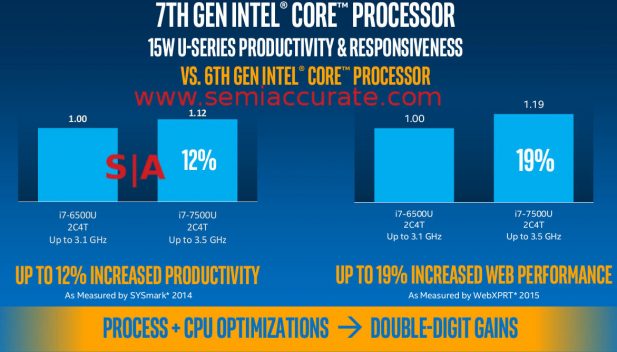
Who else can innovate at double-digit rates?
Look at that advance, 12% in just one year over the now obsolete 6th Gen ‘Skylake” CPU line. How did they do it? The all new Kaby lake is runs at a blistering 13% higher clock rate, up to 3.5GHz single core turbo for the i7-7500 versus a mere 3.1GHz of the i7-6500U. This is the kind of innovative sub-linear scaling that makes a product stand out and earn the terms Stunning, Sensory, Active, and Engaging. Better yet the same CPU is 19% faster on WebXPRT likely due to a similar massive jump in GPU frequency. Intel wisely would not disclose GPU frequencies likely for the same reason they didn’t disclose them last time, the competition might be reading this. Really.
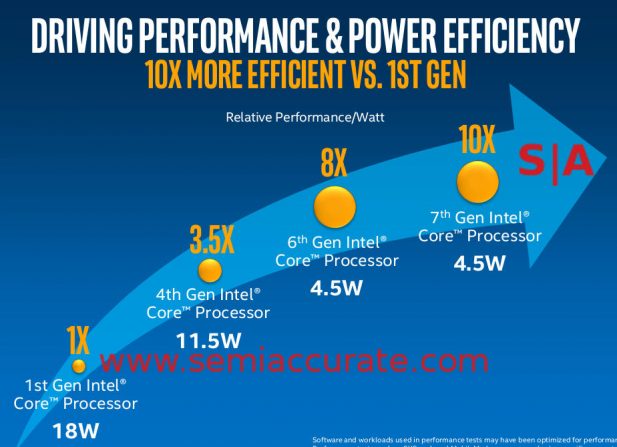
Compound interest rates add up
Raw performance like this doesn’t come for free unless you are Intel, then it comes from innovation. How much innovation? 10x, yes we are serious and do mean ten times over seven generations or eight years since the 1st Gen Core (Nehalem) launched on November 2008. If you run the numbers that is a whopping ~33% increase in efficiency per year. More innovative is the microarchitectural changes which, when removing the power, bring a stunning 2.5x performance increase in those same eight years. 12% single threaded performance increase per year for eight running, truly Stunning, Sensory, Active, and Engaging. That kind of 2.5x jump hasn’t been seen since the 386->486 change, or the 486->Pentium, or the Pentium ->Pentium II days.
This innovation train is resulting in Whaaaat?!? Over 100 designs in Q4/2016, a display of market dominance not seen since the Computex 2012 Thunderbolt OEM spread. All of these designs will benefit from another killer feature of Kaby Lake, 4K video hardware. This block can not only encode 4K video but it can transcode it faster than realtime on some select SKUs. The highest end 4.5W CPU can transcode 4Kp30 to 1080p 2x faster than realtime while the top 15W SKU can do it at 3x realtime. Luckily for the Intel engineers there is still room left for future innovations, the 4Kp60 encode bar is likely to be jumped soon enough.
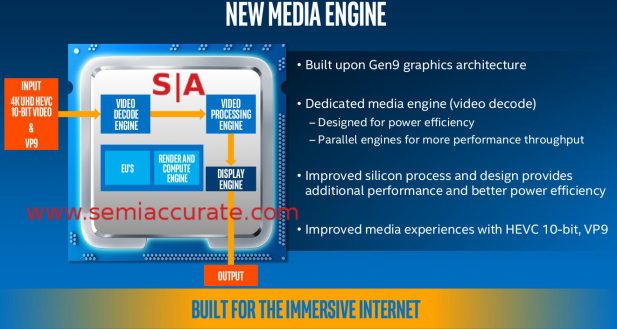
Not one but two real innovative lines
For those who think this is impossible, the author has had a cell phone in his pocket which is capable of better than realtime 4Kp60 encode for more than a year. PC user will benefit from this innovation too when Intel is ready to talk about it, but even the details of which SKUs can actually do the claimed 4Kp30 encoding are again too sensitive for Intel to disclose at the moment. Better yet this innovative feature works so fast in “Performance mode”, a lower quality but faster encoder. With advances like this, the 7th Gen Core CPU line allows the user to pick speed or quality, older devices like the Qualcomm SoC in my cell phone denies me that choice.
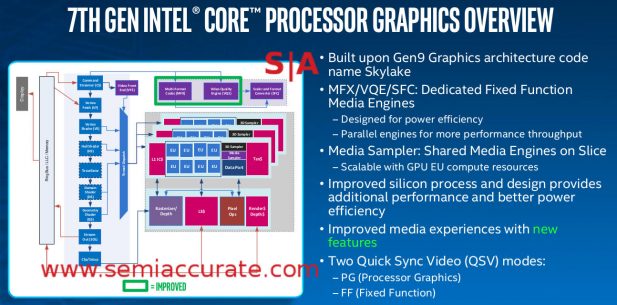
Plentiful green improvements
As you can see the changes from the 6th Gen Core line GPU to the one in the 7th Gen Core are massive, massive and green. Not only is all this real estate upgraded but they contain added modes. Yes you heard that right, Kaby Lake can now do 10b HEVC and VP9 encode and decode at nearly realtime speeds on top bin SKUs, can your cell phone or discrete GPU do that? Only if they are older than Kaby Lake and it’s innovative GPU. The same goes for HDR processing and Rec.2020 wide color gamut support. In future generations the Intel GPU itself will be upgraded to drive a 4K screen without lag in things other than video playback but at the moment some of the 7th Gen Core CPUs can transcode movies down to a supported 1080p screen without lag for a Stunning, Sensory, Active, and Engaging experience.
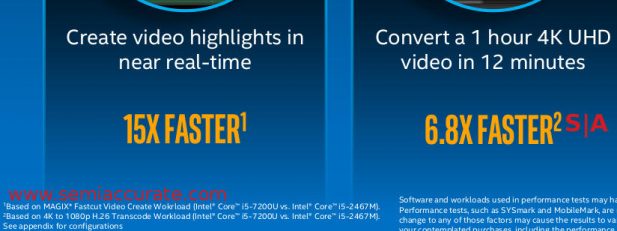
Sandy Bridge can’t keep up with innovation
Without the innovative 4K encode block none of this would be possible in a tolerable time frame. How staggering a speed increase does Kaby Lake deliver? How about a 6.8x increase in speed, yes you can convert a 1 hour 4K video to 1080p in a mere 12 minutes. If you want high quality transcoding you need to use the CPU and it will take much longer, a number so innovative Intel did not disclose it. Even then the 12% raw speed boost from other Kaby innovations would still make it faster than the comparison system, a 2nd Gen Core (Sandy Bridge) i5-2467M. A little under 7x performance increase in 7 years, that is continuous innovation at work from dedicated hardware blocks. If you don’t think so, go try doing the same thing on your year or two old cell phone, it won’t be much faster than the Kaby system while drawing how much power again? Innovation, real innovation.
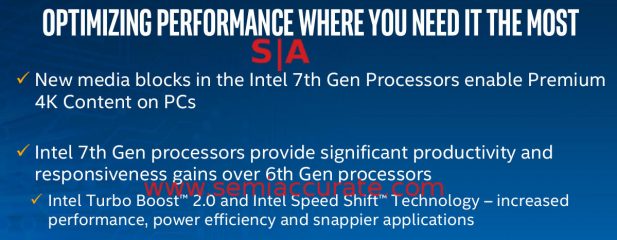
The list of innovations goes on and on, yes two ons
As you can see above, the numerous innovations and upgrades to Kaby Lake from Skylake exemplify why Intel chose to call this like 7th Generation Core rather than 6th Generation Core. The hardware 4K encoder delivers a 6.8x increase in performance versus a five-year old CPU, raw numerical performance rises “More than 70%” in that same 5+ years, a gain of nearly 12% per year. The only thing left to ask is why they didn’t call this innovation powerhouse 8th Generation Core, it deserves at least that much.S|A
Charlie Demerjian
Latest posts by Charlie Demerjian (see all)
- AMD outs MI300 plans… sort of - Apr 11, 2024
- Qualcomm is planning a lot of Nuvia/X-Elite announcements - Mar 25, 2024
- Why is there an Altera FPGA on QTS Birch Stream boards? - Mar 12, 2024
- Doogee (Almost) makes the phone we always wanted - Mar 11, 2024
- Intel Birch Stream Boards Speak From The SIde - Mar 6, 2024